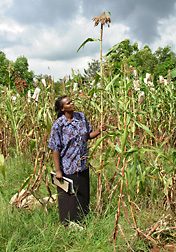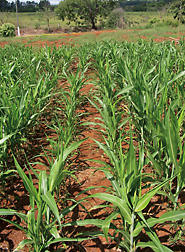Gene Identified as Key to Sorghum’s Survival in Toxic Soils
|
|
Though many of the world’s acidic soils have aluminum levels that are toxic to food plants, subsistence farmers often depend on these soils to survive. ARS plant physiologist Leon Kochian has been a part of a multinational effort to find a gene in sorghum—a key food crop in Africa—to protect it against aluminum toxicity in acidic soils.
“A lot of this work is targeted for developing countries,” Kochian says. “We’re conducting basic research with a global mission.”
Kochian leads the ARS Robert W. Holley Center for Agriculture and Health, in Ithaca, New York. For this sorghum research, he collaborated with his former Ph.D. student, Jurandir V. Magalhaes. Magalhaes is a scientist with EMBRAPA Maize and Sorghum, a branch of the Brazilian Agricultural Research Corporation (EMBRAPA), Brazil’s federal agricultural research agency.
The scientists knew that grasses like corn, rice, and wheat use membrane transporters to protect against subsoil aluminum. When aluminum levels are high, the transporters prompt a release of organic acid from the tip—or apex—of the root. The organic acid bonds with the aluminum ion and prevents entry of aluminum into the root.
In wheat, aluminum tolerance is regulated by a membrane transporter encoded by the aluminum-tolerance gene ALTM1. The research team found a gene in sorghum that protects it from soil aluminum via mechanisms that closely parallel ALTM1’s activity.
Wheat’s ATLM1 gene encodes a transporter that facilitates the release of malic acid. But in sorghum, the aluminum-tolerance gene encodes a transporter that prompts the release of citric acid. The sorghum transporter—dubbed SbMATE—is not related to the wheat transporter and is a member of the “multidrug and toxic compound extrusion,” or MATE, family of transporters.
The team found that the SbMATE gene is activated in the roots of aluminum-tolerant sorghum only when aluminum is present in the soil. Under these conditions, SbMATE is most highly expressed in the first centimeter of the root tip, which allows for protection of the root tip from aluminum.
The researchers also saw that sorghum’s ability to tolerate soil aluminum increased significantly the longer it was exposed to the element. This finding correlates with both the increased release of organic acids from the sorghum root over time and with the increased expression of SbMATE that results from exposure to soil aluminum.
Taken together, these findings support the identification of SbMATE as a new gene for aluminum tolerance. The researchers also found that SbMATE is a major determinant of aluminum tolerance in other sorghum accessions.
“I think we’ve found evidence for the co-evolution of an important grass family trait by totally different genes,” Kochian says. ARS and EMBRAPA are now engaged in collaborative projects with plant breeders in Africa to develop aluminum-tolerant sorghum varieties for cultivation in regional soils.
This work was recently published in the journal Nature Genetics.—By Ann Perry, Agricultural Research Service Information Staff.
This research is part of Plant Biological and Molecular Processes, an ARS national program (#302) described on the World Wide Web at www.nps.ars.usda.gov.
Leon V. Kochian is director of the Robert W. Holley Center for Agriculture and Health, Cornell University, Tower Road, Ithaca, NY 14853-2901; phone (607) 255-2454, fax (607) 255-2739.
"Gene Identified as Key to Sorghum’s Survival in Toxic Soils" was published in the November/December 2008 issue of Agricultural Research magazine.








